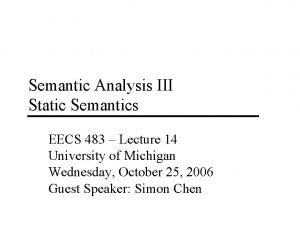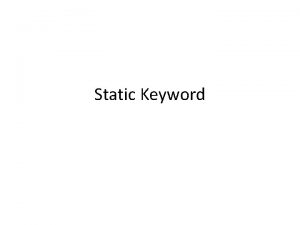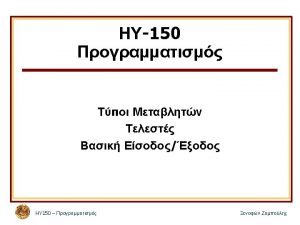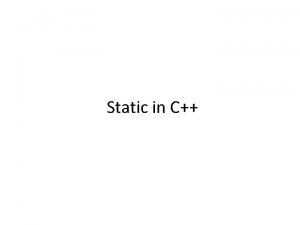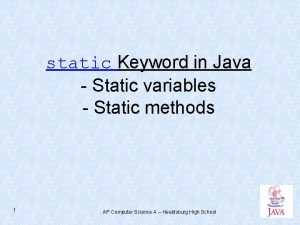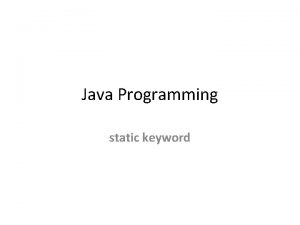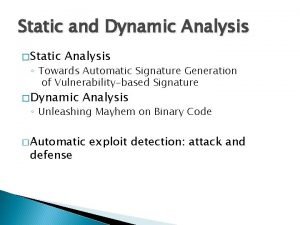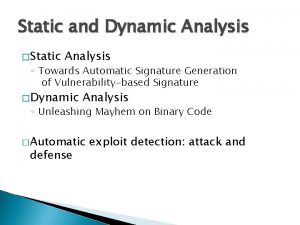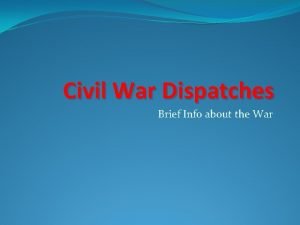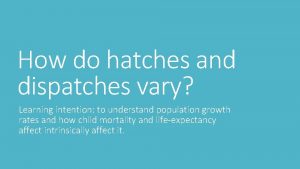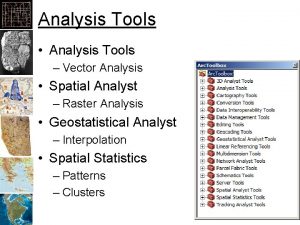Static Analysis Tools in Industry Dispatches From the

























![[Some slides omitted] 26 Confidential: For Coverity and Partner use only. Copyright Coverity, Inc. [Some slides omitted] 26 Confidential: For Coverity and Partner use only. Copyright Coverity, Inc.](https://slidetodoc.com/presentation_image/1c0b997339d572e24232a753fa3c4109/image-26.jpg)










![[Some slides omitted] 37 Confidential: For Coverity and Partner use only. Copyright Coverity, Inc. [Some slides omitted] 37 Confidential: For Coverity and Partner use only. Copyright Coverity, Inc.](https://slidetodoc.com/presentation_image/1c0b997339d572e24232a753fa3c4109/image-37.jpg)








- Slides: 45

Static Analysis Tools in Industry: Dispatches From the Front Line Dr. Andy Chou Chief Scientist and Co-founder Coverity, Inc.

Outline • Things I know • A little bit about Coverity • Bug-Finding: Technology + Philosophy + Engineering • Beyond Bug-Finding: Fixing • What I will show you • Demonstration of Coverity Static Analysis • What I think I know • Making Money: Business model + Trials + Data • Socioeconomic aspects of developers and tools • A few specific problems that want to be solved • Pure speculation 2 Confidential: For Coverity and Partner use only. Copyright Coverity, Inc. , 2011

Coverity Founders Andy Chou Dawson Engler 3 Ben Chelf Seth Hallem Confidential: For Coverity and Partner use only. Copyright Coverity, Inc. , 2011 Dave Park

It Started with Research (1999 -2003) Checking System Rules Using System-Specific, Programmer. Written Compiler Extensions, OSDI 2000 Using Meta-level Compilation to Check FLASH Protocol Code, ASPLOS 2000 An Empirical Study of Operating Systems Errors, SOSP 2001 A System and Language for Building System-Specific, Static Analyses, PLDI 2002 ARCHER: Using Symbolic, Path-sensitive Analysis to Detect Memory Access Errors, FSE 2003. . . and more 4 Confidential: For Coverity and Partner use only. Copyright Coverity, Inc. , 2011

About Coverity • Founded in 2003 • Bootstrapped until 2007 • $22 m venture funding in 2007 from Foundation and Benchmark Capital As of mid-2011: • 190+ employees • 1100+ customers • 100, 000+ users worldwide • Estimated 3 -5 billion lines of code actively scanned • Headquartered in San Francisco with offices in Boston, Calgary, Tokyo, and London 5 Confidential: For Coverity and Partner use only. Copyright Coverity, Inc. , 2011

Static Analysis Source Code char *p; if(x == 0) p = foo(); else p = 0; if(x != 0) s=*p; else. . . ; return; 6 Symbolic CFG Analysis Defects detected char *p if (x == 0) true false p = foo() p=0 if(x != 0) x!=0 taking true branch true false . . . s=*p return Confidential: For Coverity and Partner use only. Copyright Coverity, Inc. , 2011 Assigning: p=0 Dereferencing null pointer p

Defective Sample Code 7 Confidential: For Coverity and Partner use only. Copyright Coverity, Inc. , 2011

Defects shown inline with the source code 8 Confidential: For Coverity and Partner use only. Copyright Coverity, Inc. , 2011

First Defect: Memory Leak Allocated “names” Checking for allocation failures for all variables Freeing “selection” instead of “names” leaked 9 Confidential: For Coverity and Partner use only. Copyright Coverity, Inc. , 2011

Second Defect: Double Freeing “selection” instead of “names” Freeing “selection” again 10 Confidential: For Coverity and Partner use only. Copyright Coverity, Inc. , 2011

C/C++ Defects That Coverity Can Find Part 1 Resource Leaks • Memory leaks • Resource leak in object • Incomplete delete • Microsoft COM BSTR memory leak Uninitialized variables • Missing return statement • Uninitialized pointer/scalar/array read/write • Uninitialized data member in class or structure Concurrency Issues • Deadlocks • Race conditions • Blocking call misuse Integer handling issues • Improper use of negative value • Unintended sign extension Improper Use of APIs • Insecure chroot • Using invalid iterator • printf() argument mismatch 11 Confidential: For Coverity and Partner use only. Copyright Coverity, Inc. , 2011 Memory-corruptions • Out-of-bounds access • String length miscalculations • Copying to destination buffers too small • Overflowed pointer write • Negative array index write • Allocation size error Memory-illegal access • Incorrect delete operator • Overflowed pointer read • Out-of-bounds read • Returning pointer to local variable • Negative array index read • Use/read pointer after free Control flow issues • Logically dead code • Missing break in switch • Structurally dead code Error handling issues • Unchecked return value • Uncaught exception • Invalid use of negative variables

C/C++ Defects That Coverity Can Find Part 2 Program hangs • Infinite loop • Double lock or missing unlock • Negative loop bound • Thread deadlock • sleep() while holding a lock Null pointer differences • Dereference after a null check • Dereference a null return value • Dereference before a null check Code maintainability issues • Multiple return statements • Unused pointer value 12 Confidential: For Coverity and Partner use only. Copyright Coverity, Inc. , 2011 Insecure data handling • Integer overflow • Loop bound by untrusted source • Write/read array/pointer with untrusted value • Format string with untrusted source Performance inefficiencies • Big parameter passed by value • Large stack use Security best practices violations • Possible buffer overflow • Copy into a fixed size buffer • Calling risky function • Use of insecure temporary file • Time of check different than time of use • User pointer dereference

Java/C# Defects That Coverity Can Find Resource Leaks • Database connection leaks • Resource leaks • Socket & Stream leaks API usage errors • Using invalid iterator • Unmodifiable collection error • Use of freed resources Concurrent data access violations • Values not atomically updated • Double checked locking • Data race condition • Volatile not atomically updated Performance inefficiencies • Use of inefficient method • String concatenation in loop • Unnecessary synchronization Program hangs • Thread deadlock 13 Confidential: For Coverity and Partner use only. Copyright Coverity, Inc. , 2011 Class hierarchy inconsistencies • Failure to call super. clone() or supler. finalize() • Missing call to super class • Virtual method in constructor Control flow issues • Return inside finally block • Missing break in switch Error handling issues • Unchecked return value Null pointer dereferences • Dereference after null check • Dereference before null check • Dereference null return value Code maintainability issues • Calling a deprecated method • Explicit garbage collection • Static set in non-static method

Philosophy + Engineering + Technology • Focus on bug finding • Focus on developer stickiness • Low false positive rate (typically <20% out of the box) • (more on next slide) • Interprocedural analysis with bottom-up function summarization • Ensures bounded memory use: only one function + summaries for callees • Each function only analyzed once; recursive cycles are broken • Context sensitive • Path sensitivity with false path pruning • Multiple independent false path pruners: integer interval solver, string logic, inequality, SAT-based • Staged analysis • Cheaper analyses are run before more expensive ones – false path pruning only run if a candidate defect is found • Parallel, incremental analysis • Android kernel: 700 k. LOC, 10 minutes with 8 -way parallel analysis from scratch 14 Confidential: For Coverity and Partner use only. Copyright Coverity, Inc. , 2011

Top reasons for low false positives • Iterative checker design • • • Start with a defect example or idea Implement a rough checker that casts a wide net Run on open source Sample first N results Address idioms, refine heuristics, add options Repeat until the checker has a low FP rate and still finds defects • Or, discard the checker altogether • Evidence-based approach • Only report defects if enough evidence is available that it is likely to be real • This also helps developers understand the results • Evidence orientation is a good way to think about what analyses will be successful • Perception: avoidance of stupid looking false positives is important • A single example of a dumb looking FP can result in loss of credibility • Credibility among a core individual / group is key to adoption 15 Confidential: For Coverity and Partner use only. Copyright Coverity, Inc. , 2011

Technologies we don’t use (much) • Pointer alias analysis • Blobs cause FP explosions • Typical tricks for achieving scalability introduce inference steps that don’t make sense to developers – e. g. field insensitivity, flow insensitivity, . . . • Checkers, derivers, and FPP do their own intraprocedural alias tracking with full understanding of what they do and don’t care about • No single unified memory model – each checker can pick its own • E. g. No resource leak is detected in this code: 16 Confidential: For Coverity and Partner use only. Copyright Coverity, Inc. , 2011

Other technologies we don’t use much • • 17 Heap structure analysis Complex string analysis Abstract interpretation (*). . . many more Confidential: For Coverity and Partner use only. Copyright Coverity, Inc. , 2011

Beyond Bug-Finding: Fixing 18 Confidential: For Coverity and Partner use only. Copyright Coverity, Inc. , 2011

The importance of workflow • What doesn’t work: Code Analysis Bugs • Why? • Bugs get fixed. False positives don’t. Over time, FP rate approaches 100%. • Unclear what should be fixed; no prioritization • Unclear who should fix what; no ownership • Workflow separates a static analysis engine from a static analysis solution. 19 Confidential: For Coverity and Partner use only. Copyright Coverity, Inc. , 2011

Defect management and collaboration • What works better: Code Analysis DB Historical Defect Merging Shared Defect Server (CIM) • Track defects across time, even if the code changes (hashing/merging) • Share triage information across developers • Prioritize and assign ownership of defects • Detect defect duplication across branches 20 Confidential: For Coverity and Partner use only. Copyright Coverity, Inc. , 2011

Deployment practices • • 21 Clean before checkin Nightly build Continuous integration Incremental nightly build + weekend full analysis Code review integration Bug fix-it day Baselining Confidential: For Coverity and Partner use only. Copyright Coverity, Inc. , 2011

Baselining • The first time static analysis runs, there may be thousands of errors • Typical: 1 defect/k. LOC, 1 MLOC code base = 1000 defects • Where to start? • Analysis answer: rank • Market’s answer: baseline • Ignore all defects on existing code (the “baseline”) • Fix defects in new code • “Someday” get around to fixing defects in old code • Why is this so popular? • Old code is in the field. It works well enough. Risk is low. • New code is unproven. It might work, or it might not. Risk is high. 22 Confidential: For Coverity and Partner use only. Copyright Coverity, Inc. , 2011

Demonstration 23 Confidential: For Coverity and Partner use only. Copyright Coverity, Inc. , 2011

Business Model We sell term-based project licenses sized by lines of code or team size. Term-based: • Customers purchase for a specific period of time, mostly 1 or 3 years. • Customers renew every year based on then project size. Project license: • We license specific named projects (e. g. a code base). Sizing: • LOC is the most common metric (with special cases to handle OS and third party code). • Team licenses are based on the total number of developers working on a project. Enterprise licenses have custom terms. 24 Confidential: For Coverity and Partner use only. Copyright Coverity, Inc. , 2011

Opportunity cost and urgency • Favorite VC questions: • Where does the budget come from? What are they NOT going to spend on? • Why now? • Decision maker is often a director of engineering or VP of engineering • ALWAYS strapped for resources • There a multitude of problems to be solve to successfully deliver product • Is this use of money the most cost-effective use of these resources? • “Why don’t we instead. . . ” • Hire 20 developers and QA engineers in low cost geography • Improve test coverage • Buy a collaborative code review tool • Developer training • Quality is not a new problem. • Companies have already tried their best to optimize resources using many methods to try to lower costs and find defects early. • New technologies need to overcome all of these optimizations and deliver ROI of many multiples more 25 Confidential: For Coverity and Partner use only. Copyright Coverity, Inc. , 2011
![Some slides omitted 26 Confidential For Coverity and Partner use only Copyright Coverity Inc [Some slides omitted] 26 Confidential: For Coverity and Partner use only. Copyright Coverity, Inc.](https://slidetodoc.com/presentation_image/1c0b997339d572e24232a753fa3c4109/image-26.jpg)
[Some slides omitted] 26 Confidential: For Coverity and Partner use only. Copyright Coverity, Inc. , 2011

Build Integration - the code must be found and parsed to be analyzed 27 Confidential: For Coverity and Partner use only. Copyright Coverity, Inc. , 2011

Support for Mimicking Dozens of Compilers • Our build integration understands: • • Compiler command line options Built-in macro definitions Compiler-specific language extensions Compiler bugs that allow nonstandard code to parse Analog Devices Visual. DSP++ ARM C and C++ Borland C++ Cosmic C Cross Compilers Freescale Codewarrior GNU GCC and G++ Green Hills C and C++/EC++ HI-TECH PICC HP a. CC IAR Embedded Workbench C/C++ Intel C++ Keil Compilers Marvell MSA 28 Confidential: For Coverity and Partner use only. Copyright Coverity, Inc. , 2011 Nokia Codewarrior for Symbian QNX C/C++ Renesas C/C++ Scratchbox SNC PPU C/C++ STMicroelectronics GNU C/C++ STMicroelectronics ST Micro C/C++ Sun (Oracle) CC and cc Tensilica Xtensa xt-xcc and xt-xtc++ Texas Instruments Code Composer Tri. Media TCS Visual Studio Wind River (formerly Diab) C/C++

Why bother with the small compilers? “We help solve your quality problem” VP of Engineering Director A Wind River (diab) Team 1 Director B Team 4 Director C Team 5 ARM ADS Team 6 Sun CC Visual Studio gcc Team 2 gcc Team 3 29 Confidential: For Coverity and Partner use only. Copyright Coverity, Inc. , 2011

Organizational structure influences product requirements through buying behavior • The higher you go in the org chart: • • The more you can charge The less they understand what you do The more they want “coverage” of all of their code The more they want a complete solution that meets more requirements • The fewer vendors they want to deal with • The more metrics you need to provide to prove value • Hence: • MISRA • C/C++/Java/C#. . . Javascript, Ada, Cobol, Objective C, PHP, Actionscript/FLASH, PL/SQL, . . . • Reports, charts, pretty pictures 30 Confidential: For Coverity and Partner use only. Copyright Coverity, Inc. , 2011

About Developers. . . • The developer persona • Resistant to change • Impatient – “time to value” needs to be very short - think coffee break. • Quick to dismiss a tool that loses credibility – hence a focus on eliminating “stupid looking false positives”. • Instant gratification – Eclipse/VS highlight as you type; continuous integration happens every half hour • Hero complex • Artist complex • “There’s no glory in fixing bugs” • Firefighter by day, arsonist by night 31 Confidential: For Coverity and Partner use only. Copyright Coverity, Inc. , 2011

Developers • Like any large human population there is a normal distribution of talent and intelligence for developers (This is getting worse for C/C++) 32 Confidential: For Coverity and Partner use only. Copyright Coverity, Inc. , 2011

Yet. . . Developer Adoption is Key • Developers need to adopt or there is no value to a tool • Priorities change like the wind howls – will the tool + process stick? • The term business model means a huge problem for renewal rate if adoption doesn’t happen • One possible solution: • • • 33 Services to integrate everything Automatic analysis “while you sleep” (or drink coffee) Automatic assignment to the right developer Proactive email notification IDE integration. . . and much more to make it smooth, seamless, and as painless as possible Confidential: For Coverity and Partner use only. Copyright Coverity, Inc. , 2011

Problems that want to be solved 34 Confidential: For Coverity and Partner use only. Copyright Coverity, Inc. , 2011

Most real-world problems are boring • Maintaining a large legacy code base • Removing dead code • Large company: probably 60%+ of code is dead • This is an ongoing tax on understanding and modifying this code • Mindset: first eliminate code that doesn’t matter, this lowers costs going forward • Visualizing code • Standards compliance • MISRA, JSF++ / DO-178 b / ISO 26262 / PCI • Defect churn / instability • Normal bug: reproduce, fix, verify fix • Developers tend to want to work the same way on static analysis defects; this requires analysis to be very stable • Tools that enable better productivity from the bottom 80% of developers • Tools are rarely put into the hands of the best people to use. They are too busy building product features. 35 Confidential: For Coverity and Partner use only. Copyright Coverity, Inc. , 2011

The non-boring real-world problems are hard • Most static analysis considers the code as a monolithic input • Development organizations don’t see it that way at all. • Their existing code works. They are changing it. They want to know: • Will this change introduce risk of customer issues? • What kind of customer issues should I expect? • Where should I expect them? • What should I test? • Am I on track to ship next month? Working • Real life is a complex trade-off Working? • They want help making this trade-off given business needs 36 Confidential: For Coverity and Partner use only. Copyright Coverity, Inc. , 2011 Change
![Some slides omitted 37 Confidential For Coverity and Partner use only Copyright Coverity Inc [Some slides omitted] 37 Confidential: For Coverity and Partner use only. Copyright Coverity, Inc.](https://slidetodoc.com/presentation_image/1c0b997339d572e24232a753fa3c4109/image-37.jpg)
[Some slides omitted] 37 Confidential: For Coverity and Partner use only. Copyright Coverity, Inc. , 2011

Pure speculation 38 Confidential: For Coverity and Partner use only. Copyright Coverity, Inc. , 2011

New languages do get adopted 1996 1973 1983 2001 1995 1986 1991 1987 1995 1993 1995 1958 1995 1974 1970 1980 39 Confidential: For Coverity and Partner use only. Copyright Coverity, Inc. , 2011 PLDI 2001 Snowbird, Utah

Getting the world to eat spinach • It is a vital and important area of inquiry to understand how to make verification technologies more palatable • Do we understand the traits that lead to language popularity, and how can we trojan horse the best ideas from modern research into something that will become popular? • Dynamic typing – less typing? Cleaner syntax? Error resilience? • Social aspects should not be underestimated • The web spawned Javascript, but nothing was ready to step in – a huge missed opportunity • More than 50% of this is being ready at the right place and the right time – and mixing this with a larger trend 40 Confidential: For Coverity and Partner use only. Copyright Coverity, Inc. , 2011

Or. . . be real about legacy code • Be realistic about what can be expected • Restrict the scope to a segment of the market – and really understand that domain and how code is specialized for it • Realize that the market is already trying to optimize and might be “good enough” with proven technologies and processes • Change assumptions to better fit what can be realistically adopted • “Everything described in the paper works. Everything else doesn’t” • Why isn’t that in the paper? That’s the most important part. • An empirical approach with negative results is vital for legacy code problems 41 Confidential: For Coverity and Partner use only. Copyright Coverity, Inc. , 2011

Conclusion 42 Confidential: For Coverity and Partner use only. Copyright Coverity, Inc. , 2011

Is there Hope? • We are still taking baby steps. . . but many companies are starting to care • When there’s a new quality initiative, someone speaks up: “Static analysis is one of the easiest things we can do. . . ” • Companies are more ready to listen after a major incident • For any given company at any given time the chances are low, but eventually everyone gets burned • The groundwork is being laid for lower barriers • Coverity and others are being deployed into build systems, processes, and management metrics • This will eventually lower the barrier to entry for new technologies on top of these platforms • Exposure to real-world problems • Other academic disciplines have the notion of “field work” • Find ways to get out there and see what real development organizations are facing 43 Confidential: For Coverity and Partner use only. Copyright Coverity, Inc. , 2011

Academic Program • • Get access to our static analysis product for a nominal fee (*) Teaching license Research license Some restrictions http: //www. coverity. com 44 Confidential: For Coverity and Partner use only. Copyright Coverity, Inc. , 2011

Q&A Andy Chou andy@coverity. com Confidential: For Coverity and Partner use only. Copyright Coverity, Inc. , 2011
 Autohotkey obfuscator
Autohotkey obfuscator Dfd advantages and disadvantages
Dfd advantages and disadvantages The appropriate cutting tool used in cutting fabrics
The appropriate cutting tool used in cutting fabrics Hát kết hợp bộ gõ cơ thể
Hát kết hợp bộ gõ cơ thể Slidetodoc
Slidetodoc Bổ thể
Bổ thể Tỉ lệ cơ thể trẻ em
Tỉ lệ cơ thể trẻ em Voi kéo gỗ như thế nào
Voi kéo gỗ như thế nào Glasgow thang điểm
Glasgow thang điểm Hát lên người ơi alleluia
Hát lên người ơi alleluia Môn thể thao bắt đầu bằng từ chạy
Môn thể thao bắt đầu bằng từ chạy Thế nào là hệ số cao nhất
Thế nào là hệ số cao nhất Các châu lục và đại dương trên thế giới
Các châu lục và đại dương trên thế giới Công thức tính thế năng
Công thức tính thế năng Trời xanh đây là của chúng ta thể thơ
Trời xanh đây là của chúng ta thể thơ Mật thư anh em như thể tay chân
Mật thư anh em như thể tay chân Làm thế nào để 102-1=99
Làm thế nào để 102-1=99 Phản ứng thế ankan
Phản ứng thế ankan Các châu lục và đại dương trên thế giới
Các châu lục và đại dương trên thế giới Thơ thất ngôn tứ tuyệt đường luật
Thơ thất ngôn tứ tuyệt đường luật Quá trình desamine hóa có thể tạo ra
Quá trình desamine hóa có thể tạo ra Một số thể thơ truyền thống
Một số thể thơ truyền thống Cái miệng nó xinh thế chỉ nói điều hay thôi
Cái miệng nó xinh thế chỉ nói điều hay thôi Vẽ hình chiếu vuông góc của vật thể sau
Vẽ hình chiếu vuông góc của vật thể sau Nguyên nhân của sự mỏi cơ sinh 8
Nguyên nhân của sự mỏi cơ sinh 8 đặc điểm cơ thể của người tối cổ
đặc điểm cơ thể của người tối cổ Thế nào là giọng cùng tên
Thế nào là giọng cùng tên Vẽ hình chiếu đứng bằng cạnh của vật thể
Vẽ hình chiếu đứng bằng cạnh của vật thể Fecboak
Fecboak Thẻ vin
Thẻ vin đại từ thay thế
đại từ thay thế điện thế nghỉ
điện thế nghỉ Tư thế ngồi viết
Tư thế ngồi viết Diễn thế sinh thái là
Diễn thế sinh thái là Các loại đột biến cấu trúc nhiễm sắc thể
Các loại đột biến cấu trúc nhiễm sắc thể So nguyen to
So nguyen to Tư thế ngồi viết
Tư thế ngồi viết Lời thề hippocrates
Lời thề hippocrates Thiếu nhi thế giới liên hoan
Thiếu nhi thế giới liên hoan ưu thế lai là gì
ưu thế lai là gì Hổ đẻ mỗi lứa mấy con
Hổ đẻ mỗi lứa mấy con Khi nào hổ mẹ dạy hổ con săn mồi
Khi nào hổ mẹ dạy hổ con săn mồi Hệ hô hấp
Hệ hô hấp Từ ngữ thể hiện lòng nhân hậu
Từ ngữ thể hiện lòng nhân hậu Thế nào là mạng điện lắp đặt kiểu nổi
Thế nào là mạng điện lắp đặt kiểu nổi Eecs 483
Eecs 483













































